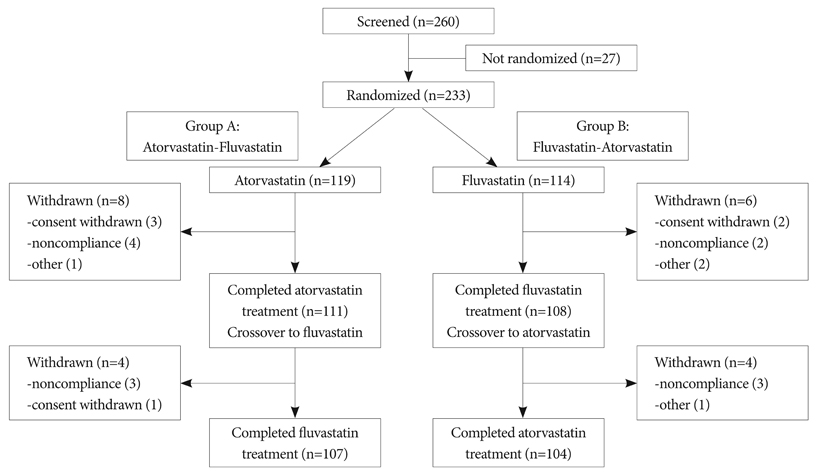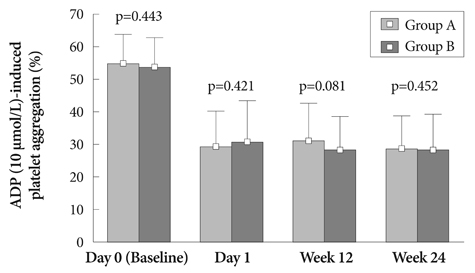Korean Circ J.
2011 Jan;41(1):28-33. 10.4070/kcj.2011.41.1.28.
Effect of Atorvastatin and Clopidogrel Co-Administration After Coronary Stenting in Korean Patients With Stable Angina
- Affiliations
-
- 1Cardiovascular Center, Sun General Hospital, Daejeon, Korea. mdzoa@paran.com
- 2Department of Neurology, Sun General Hospital, Daejeon, Korea.
- 3Cardiovascular Center, Chungnam National University Hospital, Daejeon, Korea.
- 4Department of Cardiology, Soonchunhyang University of College of Medicine, Seoul, Korea.
- KMID: 2225151
- DOI: http://doi.org/10.4070/kcj.2011.41.1.28
Abstract
- BACKGROUND AND OBJECTIVES
It was reported that atorvastatin co-administered with clopidogrel for 8 months did not affect the anti-platelet potency of clopidogrel in Korean patients with acute coronary syndrome, but not in patients with stable angina. We investigated whether co-administration of statins with clopidogrel affected the anti-platelet efficacy of clopidogrel in Korean patients with stable angina.
SUBJECTS AND METHODS
This was a randomized, open-label and two-period crossover design study conducted at two centers. Two hundreds thirty three patients with stable angina scheduled for coronary stenting were randomized into two groups. In Group A, 119 patients first received atorvastatin (10 mg) followed by fluvastatin (80 mg) for 12 weeks per treatment. In Group B, 114 patients received the same treatments in reverse order.
RESULTS
Baseline adenosine diphosphate (ADP, 10 micromol/L)-induced platelet aggregation was 54.4+/-9.1% in Group A and 53.8+/-9.0% in Group B (p=0.44), and significant differences were noted after each treatment period (p<0.001). Inhibition of platelet aggregation was similar between Group A and Group B at 24 hours following clopidogrel loading (29.2+/-11.0% vs. 30.4+/-12.7%; p=0.42). The two treatment least square means of 12-week ADP (10 mol/L)-induced platelet aggregation [29.50+/-0.79 {standard error (SE)}% on the atorvastatin treatment group vs. 28.16+/-0.70 (SE)% in the fluvastatin treatment group] in a 2x2 cross-over study were not significantly different (p=0.204).
CONCLUSION
Statin and clopidogrel co-administration for 12 weeks is not associated with attenuated anti-platelet activity of clopidogrel in Korean patients with stable angina after coronary stenting, in support of the findings of similar studies conducted in Caucasian populations.
Keyword
MeSH Terms
-
Acute Coronary Syndrome
Adenosine Diphosphate
Angina, Stable
Cardiovascular Diseases
Cross-Over Studies
Cytochrome P-450 CYP3A
Fatty Acids, Monounsaturated
Heptanoic Acids
Humans
Hydroxymethylglutaryl-CoA Reductase Inhibitors
Indoles
Platelet Aggregation
Pyrroles
Stents
Ticlopidine
Atorvastatin Calcium
Adenosine Diphosphate
Cytochrome P-450 CYP3A
Fatty Acids, Monounsaturated
Heptanoic Acids
Hydroxymethylglutaryl-CoA Reductase Inhibitors
Indoles
Pyrroles
Ticlopidine
Figure
Reference
-
1. CAPRIE Steering Committee. A randomised, blinded, trial of clopidogrel versus aspirin in patients at risk of ischaemic events (CAPRIE). Lancet. 1996. 348:1329–1339.2. Chae SC. Antiplatelet agents in high-risk patients with coronary artery disease. Korean Circ J. 2004. 34:23–27.3. Bertrand ME, Rupprecht HJ, Urban P, Gershlick AH. Double-blind study of the safety of clopidogrel with and without a loading dose in combination with aspirin compared ticlopidine in combination with aspirin after coronary stenting: the Clopidogrel Aspirin Stent International Cooperative Study (CLASSICS). Circulation. 2000. 102:624–629.4. Yusuf S, Zhao F, Mehta SR, Chrolavicius S, Tognoni G, Fox KK. Effects of clopidogrel in addition to aspirin in patients with acute coronary syndromes without ST-segment elevation. N Engl J Med. 2001. 345:494–502.5. Bhatt DL, Bertrand ME, Berger PB, et al. Meta-analysis of randomized and registry comparisons of ticlopidine with clopidogrel after stenting. J Am Coll Cardiol. 2002. 39:9–14.6. Schömig A, Neumann FJ, Kastrati A, et al. A randomized comparison of antiplatelet and anticoagulant therapy after the placement of coronary-artery stents. N Engl J Med. 1996. 334:1084–1089.7. Cutlip DE, Baim DS, Ho KK, et al. Stent thrombosis in the modern era: a pooled analysis of multicenter coronary stent clinical trials. Circulation. 2001. 103:1967–1971.8. Schömig A, Mehilli J, Holle H, et al. Statin treatment following coronary stenting and one-year survival. J Am Coll Cardiol. 2002. 40:854–861.9. Baek JH, Choe KH, Jun JE, et al. Multicenter clinical trial of atorvastatin in patients with hypercholesterolemia. Korean Circ J. 2001. 31:434–441.10. Yun KH, Park HY, Choi JH, et al. Comparison of efficacy and safety after administering high potency statin to high risk patients: rosuvastatin 10 mg versus Atorvastatin 20 mg. Korean Circ J. 2007. 37:154–160.11. Savi P, Herbert JM, Pflieger AM, et al. Importance of hepatic metabolism in the antiaggregating activity of the thienopyridine clopidogrel. Biochem Pharmacol. 1992. 44:527–532.12. Savi P, Combalbert J, Gaich C, et al. The antiaggregating activity of clopidogrel is due to a metabolic activation by the hepatic cytochrome P450-1A. Thromb Haemost. 1994. 72:313–317.13. Savi P, Pereillo JM, Uzabiaga MF, et al. Identification and biological activity of the active metabolite of clopidogrel. Thromb Haemost. 2000. 84:891–896.14. Clarke TA, Wakell LA. The metabolism of clopidogrel is catalyzed by human cytochrome p450 3A and is inhibited by atorvastatin. Drug Metab Dispos. 2003. 31:53–59.15. Lau WC, Waskell LA, Watkins PB, et al. Atorvastatin reduces the ability of clopidogrel to inhibit platelet aggregation: a new drug-drug interaction. Circulation. 2003. 107:32–37.16. Neubauer H, Günesdogan B, Hanefeld C, Spiecker M, Mügge A. Lipophilic statins interfere with the inhibitory effects of clopidogrel on platelet function: a flow cytometry study. Eur Heart J. 2003. 24:1744–1749.17. Saw J, Steinhubl SR, Berger PB, et al. Lack of adverse clopidogrel-atorvastatin clinical interaction from secondary analysis of a randomized, placebo-controlled clopidogrel trial. Circulation. 2003. 108:921–924.18. Wienbergen H, Gitt AK, Schiele R, et al. Comparison of clinical benefits of clopidogrel therapy in patients with acute coronary syndromes taking atorvastatin versus other statin therapies. Am J Cardiol. 2003. 92:285–288.19. Mitsios JV, Papathanasiou AI, Rodis FI, Elisaf M, Goudevenos JA, Tselepis AD. Atorvastatin does not affect the antiplatelet potency of clopidogrel when it is administered concomitantly for 5 weeks in patients with acute coronary syndromes. Circulation. 2004. 109:1335–1338.20. Serebruany VL, Midei MG, Malinin Al, et al. Absence of interaction between atorvastatin or other statins and clopidogrel: results from the interaction study. Arch Intern Med. 2004. 164:2051–2057.21. Mukherjee D, Kline-Rogers E, Fang J, Munir K, Eagle KA. Lack of clopidogrel-CYP3A4 statin interaction in patients with acute coronary syndrome. Heart. 2005. 91:23–26.22. Geisler T, Zürn C, Paterok M, et al. Statins do not adversely affect post-interventional residual platelet aggregation and outcomes in patients undergoing coronary stenting treated by dual antiplatelet therapy. Eur Heart J. 2008. 29:1635–1643.23. Hong SJ, Park JY, Kim KA, et al. Comparison of low vs moderate dose of atorvastatin in clopidogrel resistance after coronary stenting in Korean patients with acute coronary syndrome. Circ J. 2009. 73:1111–1118.24. WMA Declaration of Helsinki-Ethical Principles for Medical Research Involving Human Subjects. World Medical Association. accessed 2 December 2008. Available at: http://www.wma.net/en/30publications/10policies/b3/index.html.25. Maron DJ, Fazio S, Linton MF. Current perspectives on statins. Circulation. 2000. 101:207–213.26. Faul F, Erdfelder E, Lang AG, Buchner A. G*Power 3: a flexible statistical power analysis program for the social, behavioral, and biomedical sciences. Behav Res Methods. 2007. 39:175–191.27. Malek LA, Kisiel B, Spiewak M, et al. Coexisting polymorphism of P2Y12 and CYP2C19 genes as a risk factor for persistent platelet activation with clopidogrel. Circ J. 2008. 72:1165–1169.28. Lee KH, Lee SW, Lee JW, et al. The significance of clopidogrel low-responsiveness on stent thrombosis and cardiac death assessed by the verifynow P2Y21 assay in patients with acute coronary syndrome within 6 months after drug-eluting stent implantation. Korean Circ J. 2009. 39:512–518.29. Mach F, Senouf D, Fontana P, et al. Not all statins interfere with clopidogrel during antiplatelet therapy. Eur J Clin Invest. 2005. 35:476–481.30. Friedewald WT, Levy RI, Fredrickson DS. Estimation of the concentration of low-density lipoprotein cholesterol in plasma, without use of the preparative ultracentrifuge. Clin Chem. 1972. 18:499–502.31. Chow SC, Liu JP. Design and Analysis of Bioavailability and Bioequivalence Studies. 1999. New York: Marcel Dekker.32. Chow SC, Shao J, Wang H. Sample Size Calculations in Clinical Research. 2003. New York: Marcel Dekker.
- Full Text Links
- Actions
-
Cited
- CITED
-
- Close
- Share
- Similar articles
-
- Angiographic Follow-up after Intracoronary Stenting with Flexible Coil(Gianturco-Roubin) Stent
- Coronary Artery Stenting(Palmaz-Schatz) ; Immediate Results
- A Case of Left Coronary Artery Milking Treated by Direct Stenting During Percutaneous Coronary Intervention in A Patient with Unstable Angina
- Clinical Experience with the Palmaz-Schatz Coronary Stent: Initial Results and 7 Month Follow-up
- Evaluation of Myocardial Ischemia Using Coronary Computed Tomography Angiography in Patients with Stable Angina




